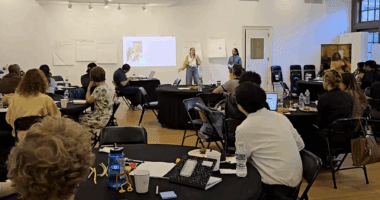The circle shape, aesthetically, allows for inclusion–everyone’s face is seen. When I first arrived at The Young Women’s Leadership School, I entered a classroom and the teenage women turned their heads to face me, a circle of shining eyes. My mentor and Teaching Artist, Jennifer Hecht, prompted the class to welcome me. In unison their voices rose to a bright hello. I was thankful that these teenagers are not at all like the young lady I was at their age, consistently sizing up new adults. No, these young women were attentive from the start.
We began the class with an opening ritual. Each class, the students begin by speaking about the homework that was assigned and the previous lesson. From there, Jennifer allows the students to share their work, and the students practically hopped out of their seats to go first. Similar to our Teaching Artist Training & Internship Program (TATIP) workshop practices, Jennifer pointed out specific examples in the students work to affirm their writing. She had clearly built a safe learning space, based on the enthusiasm of the students and their willingness to share their newly crafted poems.
Most of the students wanted to share. And while the class focus centered on choice, Jennifer also made it a point to involve students that were not volunteering. She called on one student at random to read their poem. At first the student declined and Jennifer asked if maybe she would like to share her favorite line from her writing. The student declined again and Jennifer did not push, she simply moved forward with the sharing session.
Later in the session, however, that same young lady volunteered to read her poem in front of the class! In my observation, I think it was the facilitator’s ability to establish a safe space that let the student feel empowered enough to eventually share her poem. This demonstrated that Jennifer’s classroom was a true exhibition of a circle. The encircled students know that they can sit amongst their peers, be present, and choose how they want to participate in the class. I remember in our TATIP Saturday sessions, Renee and Patti stressed the importance of permeating choice in the residencies. So much of the school day is regimented and strict that Jennifer’s flexibility in the classroom empowered the girls and allowed them to make their own choices and affirm themselves as thoughtful, intelligent young women. This technique was so effective that even the shyest student, particularly the young lady who had previously refused to participate, felt comfortable enough to break from her cocoon and receive feedback from both Jennifer and the other girls.
After the sharing session, Jennifer returned to the story that they had covered the previous week, Little Red Riding Hood. Her aim was to remind them of the use of symbols in storytelling and to showcase how to use it in their poetry. The students recalled a discussion from the previous week in which they identified certain symbols in the story, such as the color red, the woods, etc.
Jennifer then handed out a poem for the students to examine and critique, noting specific symbols and forms. Jennifer chose to bring in one of her own poems for the students to examine, which happened to be a question poem. This was a distinct choice that I had never thought to implement in my own teaching. Her idea was that by teaching from a poem that she had written, she could, as the author, give the students direct answers about poetic choices in the poem. Her use of the poem as an example of the homework that she assigned was a tactic that I had seen used in our TATIP trainings and now I see how effective this method can be. It is a technique I plan to use in my own teaching.
Jennifer ended class by assigning homework for the students to write a question poem. She made it clear that the questions could be based on anything the student decided. Overall, I noticed that Jennifer used many of the tactics I learned in those TATIP workshops and this allowed me to see those classroom goals, rituals and activities implemented effectively. I found myself exiting the classroom as anxious as the students for the next class where the girls would present freshly revised versions their poems.
-Nabila Lovelace, Poet, TATIP Trainee



